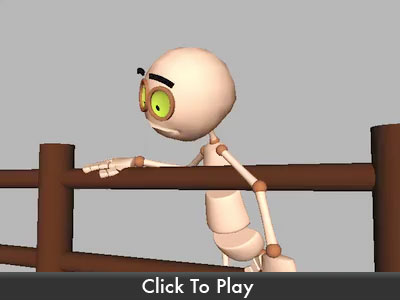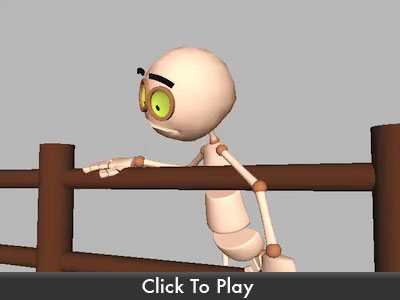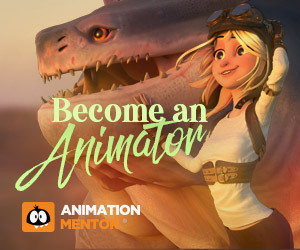Helpful Hints
A collection of tips and tricks to help you with your entries.
Between The Words
By: Eric Scheur
Published June 18th, 2009
Most of the audio files you'll ever hear at the 11 Second Club are dialogue-driven. This means that you're likely to spend a good deal of time and energy concentrating on how your character will perform the lines they deliver in your scene.
But there is a lot more to a successful scene than simply animating the dialogue you hear. In an eleven second clip of dialogue, there's a lot that you're not hearing. Today's Helpful Hint will examine two areas you may be neglecting simply because it's not part of what the character is saying. We'll be looking between the words.
There's a story from recent Disney lore that goes like this:
One day, Glen Keane was working on some test shots for the upcoming CG film, Rapunzel. After seeing his shot rendered, he was thrilled with the quality of the visuals; every hair on the heroine's head, every shadow that fell on her delicate face. He was so excited about the scene, in fact, that he rushed off to find his mentor, Ollie Johnston.
Ollie had been one of Disney's "Nine Old Men" and remains one of the most respected animators that the field has ever seen. He was known for bringing to life dozens of beloved characters in Disney's films, and making each one of them real and believable with his deep and considered acting choices.
Glen (no slouch at Disney himself, mind you) sat Ollie down in front of the fresh-from-the-render-farm shot and played it for him. Glen went on and on about the kind of visuals they were achieving, and how no CG film had ever had the kind of beautiful sheen that they were going to have on this one.
Ollie sat quietly watching the footage while Glen eagerly search the old man's face for any trace of shared excitement. Finally, he simply had to beg Ollie "Well, what do you think??"
Ollie took a moment before saying, in a calm and measured voice, "Well, Glen... I just have one question: What is she thinking?"
And there it is. Your characters don't merely speak the lines that they're given; the audience should be able to read that these are living, breathing souls with feelings and thoughts all of their own. Your job as an animator is to present your characters in a way that will make the audience believe all of these things are true. There are a a million ways to tackle this challenging task. Right now we're going to look at one small way to inject some good ol' thought and intention into your characters.
A poor actor will deliver his lines in a way that sound wooden and scripted, while a talented actor will be able to say those same lines and make you feel that he just came up with them that moment. It's the difference between already knowing what you're going to say, and considering your words to make sure you're expressing your ideas properly.
Wouldn't it be great if you could study only those quick moments of decision and reflection that happen before and after the speaking? Look no further than BaseDesign's Perspectives project. On their site you can find over a dozen interviews that focus on what the subjects don't say.
Watch the way Enrique's mouth forms around words that aren't there, how his lips struggle for the right degree of smile before speaking. Look at the way Olga's eyes search around for the ideas she wants to express before she says them, and how her bottom lip curls up and even gets sucked into her mouth when she happens upon an unexpected thought she's unsure will be received well.
These are the moments that make us understand "Ooh, this person is thinking! They don't know what they're going to say before they say it!"
Visit the Perspectives site for more videos, or even try it yourself with your own footage! It's amazing how much is there if we just know where to look.
Now for part two, folks! Have a listen to this audio clip:
This is from Spellbound, a charming documentary about the young men and women competing in the 1999 National Spelling Bee. If you haven't seen it yet, it's definitely worth a spot in your Netflix queue.
But back to our subject. You can definitely hear that this girl is passionate about her subject, with a little bit of a sense of humor about the times that she has lost. She will do her best during the next competition, but if she doesn't win, she knows that she's just going to have another addition to this list that reminds her of past failures. If I were blocking out this scene (and, you know, I am), I might approach it something like this:
I'm pretty happy with the direction it's going. But if I were to really scrutinize things, even this early in the blocking stage, I'd notice that there is something very important missing.
We're told "Listen to your audio over and over. Listen until you're sick of it. Listen until you know every little nuance and subtle turn, because those are the things that will help you craft a real and believable performance." If I had paid close attention to my audio the first time around, I would have noticed that there was something else very important between the words. Let's check out that audio one more time:
Ah ha!
Chances are that you hear much more breathing in any given day than you hear talking. It's so common, and so unassuming, that we tend not to even notice it even when it's right in front of our ears. But if you didn't stop to breathe, your lungs wouldn't be able to take in all of the oxygen that fuels our bodies. If you run low on oxygen, your body starts to panic and make any attempt it can to bring in its much-needed oxygen quickly--this is why you gasp for air if you've been underwater for too long, and why you breathe heavily if you've just been exercising. Talking is no different. When you talk, you are stopping your body from absorbing any oxygen. Your body and brain compensate for this by taking shorter, quicker breaths during those brief moments between the words. That's why those breaths tend to be more audible, and also why your audience will sense something is missing when they don't see your character breathing in those spaces. It's a natural human function, and even an untrained eye will feel that something isn't right if it isn't there.
I'm going to re-adjust some timing, add in a few more keyframes and see how my blocking looks now that I've paid attention to my character's breathing:
Much better now. Adding in those few details suddenly makes her seem more like a real person that needs oxygen for her lungs than an animatronic figure who merely responds to previously-programmed gestures.
As animators, it is our responsibility to pay attention to the smallest of details. There are tiny little facial tics and vocal pauses that we take for granted in everyday life. But when we set down to use a character in a performance, the more tiny details we're aware of, the better we are able to create the illusion of a living, breathing soul. The dialogue in any audio clip is a great place to get an idea of the broad strokes of a performance; the meaning of the words, the delivery, the accentuated syllables, the pacing. But there are layers and layers to explore between the words that will make your work stand out.
Until next month, breathe deeply, and happy animating!
- Eric
comments powered by Disqus










